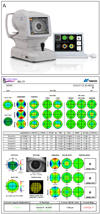Abstract
Purpose
To evaluate changes in corneal and ocular high-order aberration, ocular fatigue, and tear break-up time (TBUT) before and after playing computer games and the correlations among the variables.
Methods
Thirty-nine normal healthy subjects played computer games for 1 hour. Ocular fatigue was evaluated with a questionnaire, TBUT was measured with slit-lamp biomicroscopy, and high-order aberrations were measured with a KR-1W aberrometer (Topcon Medical System, Inc., Tokyo, Japan) in each subject before and after playing computer games. The right eye was used for statistical analyses.
Results
Subjective ocular fatigue (expressed as the interview score) increased from 4.23 ± 5.35 to 12.05 ± 8.68 after playing games (p < 0.001) and TBUT decreased from 8.03 ± 6.43 sec to 4.90 ± 3.31 sec (p < 0.001). Ocular high-order aberrations in the 4 mm and 6 mm zones were not significantly changed before and after playing games (p = 0.150, p = 0.202, respectively). However, corneal high-order aberrations in the 4 mm and 6 mm zones were significantly increased after playing computer games (p = 0.002, p = 0.002, respectively). Changes in TBUT, interview score, and corneal high-order aberration were not correlated with each other.
Figures and Tables
Table 2
Blinking count, break-up time, ocular protection index, interview score and spherical equivalent before and after computer game

Table 3
The changes of ocular, corneal, and internal high order aberration before and after playing computer games

Table 4
Correlation coefficients between changes of corneal high order aberration and other values

All values p > 0.05.
DiffCor 4 mm = corneal aberration difference in 4 mm; DiffCor 6 mm = corneal aberration difference in 6 mm; PreBUT = pregame break-up time; PostBUT = postgame break-up time; PreInterv = pregame interview score; PostInterv = postgame interview score; PreOPI = pregame ocular protection index; PostOPI = postgame ocular protection index; DiffBUT = break-up time difference; DiffInterv = interview score difference; DiffOPI = ocular protection index difference.
References
1. Kim JS, Cho KJ, Song JS. Influences of computer works on blink rate and ocular dryness in adolescents. J Korean Ophthalmol Soc. 2007. 48:1466–1472.
2. Thomson WD. Eye problems and visual display terminals--the facts and the fallacies. Ophthalmic Physiol Opt. 1998. 18:111–119.
3. Böös SR, Calissendorff BM, Knave BG, et al. Work with video display terminasl among office employees. III. Ophthalmologic factors. Scand J Work Environ Health. 1985. 11:475–481.
4. Yaginuma Y, Yamada H, Nagai H. Study of the relationship between lacrimation and blink in VDT work. Ergonomics. 1990. 33:799–809.
5. Cho YA, Won JS, An GJ. The effect on the dryness of eye during VDT work. J Korean Ophthalmol Soc. 1996. 37:1991–1995.
6. Kim JH, Kang KT, Cho YA. The influence of the vertical location of VDT screen on the ocular dryness. J Korean Ophthalmol Soc. 1997. 38:1328–1335.
7. Park HJ, Yi K. Relationship between middle school students' computer using time and dry eye. J Korean Ophthalmol Soc. 2002. 43:449–454.
8. Piñero DP, Juan JT, Alió JL. Intrasubject repeatability of internal aberrometry obtained with a new integrated aberrometer. J Refract Surg. 2011. 27:509–517.
9. Ames SL, Wolffsohn JS, McBrien NA. The development of a symptom questionnaire for assessing virtual reality viewing using a head-mounted display. Optom Vis Sci. 2005. 82:168–176.
10. Suh YW, Kim KH, Kang SY, et al. The objective methods to evaluate ocular fatigue associated with computer work. J Korean Ophthalmol Soc. 2010. 51:1327–1332.
11. Ousler GW 3rd, Hagberg KW, Schindelar M, et al. The Ocular Protection Index. Cornea. 2008. 27:509–513.
12. Himebaugh NL, Begley CG, Bradley A, Wilkinson JA. Blinking and tear break-up during four visual tasks. Optom Vis Sci. 2009. 86:E106–E114.
13. Jeong JH, Kim MJ, Tchah HW. Clinical comparison of laser ray tracing aberrometer and Shack-Hartmann aberrometer. J Korean Ophthalmol Soc. 2006. 47:1911–1919.
14. Himebaugh NL, Begley CG, Bradley A, Wilkinson JA. Blinking and tear break-up during four visual tasks. Optom Vis Sci. 2009. 86:E106–E114.
15. Montés-Micó R, Cáliz A, Alió JL. Wavefront analysis of higher order aberrations in dry eye patients. J Refract Surg. 2004. 20:243–247.
16. Koh S, Maeda N, Hori Y, et al. Effects of suppression of blinking on quality of vision in borderline cases of evaporative dry eye. Cornea. 2008. 27:275–278.




 PDF
PDF ePub
ePub Citation
Citation Print
Print




 XML Download
XML Download